CPU/Entwicklung: Unterschied zwischen den Versionen
Erscheinungsbild
Keine Bearbeitungszusammenfassung |
Keine Bearbeitungszusammenfassung |
||
| Zeile 47: | Zeile 47: | ||
|[[Datei:Intel core i7-3770k Unterseite.jpg|100px|rahmenlos|Ivy Bridge i7-3770k Unterseite]]||2012||Intel||i7 Ivy Bridge||1.400.000.000||64-Bit||4||4||2,5-3,5 GHz||0,22 μm | |[[Datei:Intel core i7-3770k Unterseite.jpg|100px|rahmenlos|Ivy Bridge i7-3770k Unterseite]]||2012||Intel||i7 Ivy Bridge||1.400.000.000||64-Bit||4||4||2,5-3,5 GHz||0,22 μm | ||
|- | |- | ||
|[[Datei: | |[[Datei:Intel i7 5930K.jpg|100px|rahmenlos|Haswell-E i7 5930K]]||2014||Intel||i7 Haswell-E||2.600.000.000||64-Bit||6||12||3,0-3,7 GHz||0,22 μm | ||
|- | |- | ||
|[[Datei:Bild|100px|rahmenlos|Besch]]||2015||Intel||i7 Broadwell||3.200.000.000||64-Bit||4||8||3,3-3,7 GHz||0,14 μm | |[[Datei:Bild|100px|rahmenlos|Besch]]||2015||Intel||i7 Broadwell||3.200.000.000||64-Bit||4||8||3,3-3,7 GHz||0,14 μm | ||
Version vom 28. Januar 2021, 07:01 Uhr
Erklärung der CPU
- CPU steht für "central processing unit", also Zentrale Verarbeitungseinheit. Der Hauptprozessor.
- Der Hauptprozessor ist die Funktionseinheit in einem Computer, der die eigentliche Verarbeitungsleistung erbringt.
- Er ist für die Informationsverarbeitung und die Steuerung der Verarbeitungsabläufe zuständig.
Mooresches Gesetz
1965 formulierte Gordon Moore das Mooresches Gesetz, welches kein Naturgesetz, sondern eher eine Faustformel ist.
Nach diesem Gesetz verdoppelt sich die Anzahl von Transistoren pro Flächeneinheit ca. alle 12 - 24 Monate.
Das Wachstum der CPU
| Datei | Einführungsjahr | Hersteller | Model / Codename | Anzahl Transistoren (ca.) | Verarbeitungsbreite | Kerne | Threads | Taktfrequenz | Strukturgröße |
 |
1975 | Intel | 8080 | 6.000 | 8-Bit | 1 | 1 | 1-2MHz | 6 μm |
 |
1978 | Intel | 8086 | 29.000 | 16-Bit | 1 | 1 | 4,77-10MHz | 3 μm this + Blockschaltbild |
 |
1980 | Intel | 8088 | 29.000 | 16-Bit | 1 | 1 | 5-10MHz | 3 μm |
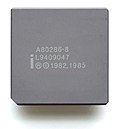 |
1982 | Intel | 80286 | 134.000 | 16-Bit | 1 | 1 | 4-26MHz | 1,5 μm |
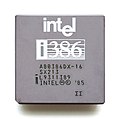 |
1985 | Intel | 80386 | 275.000 | 32-Bit | 1 | 1 | 12-40MHz | 1,5 μm bis 1,0 μm this |
 |
1989 | Intel | 80486 | 1.180.000 | 32-Bit | 1 | 1 | 16-100MHz | 1 μm bis 0,6 μm |
 |
1993 | Intel | Pentium | 3.100.000 | 32-Bit | 1 | 1 | 60-66MHz | 0,8 μm this |
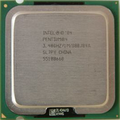 |
2004 | Intel | Pentium 4 "Prescott" | 125.000.000 | 64-Bit | 1 | 1-2 | 1,3-3,8GHz | 0,90 μm |
 |
2007 | Intel | Core 2 "Wolfdale" | 410.000.000 | 64-Bit | 4 | 4 | 1,3-3,33 GHz | 0,45 μm |
 |
2008 | Intel | i7 Nehalem "Bloomfield" | 731.000.000 | 64-Bit | 4 | 4 | 2,6-3,2 GHz | 0,45 μm |
 |
2009 | Intel | i5 Nehalem "Lynnfield" | 774.000.000 | 64-Bit | 4 | 4 | 2,66-3,06 GHz | 0,45 μm |
 |
2010 | Intel | i7 Westmere "Gulftown" | 1.170.000.000 | 64-Bit | 6 | 6 | 3,2-3,46 GHz | 0,32 μm |
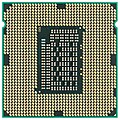 |
2011 | Intel | i7 Sandy Bridge | 1.160.000.000 | 64-Bit | 4 | 4 | 2,8-3,5 GHz | 0,32 μm |
 |
2012 | Intel | i7 Ivy Bridge | 1.400.000.000 | 64-Bit | 4 | 4 | 2,5-3,5 GHz | 0,22 μm |
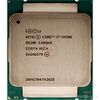 |
2014 | Intel | i7 Haswell-E | 2.600.000.000 | 64-Bit | 6 | 12 | 3,0-3,7 GHz | 0,22 μm |
| Besch | 2015 | Intel | i7 Broadwell | 3.200.000.000 | 64-Bit | 4 | 8 | 3,3-3,7 GHz | 0,14 μm |
| Besch | 2015 | Intel | i7 Skylake | 1.750.000.000 | 64-Bit | 4 | 8 | 3,8-4,0 GHz | 0,14 μm |
| Besch | 2017 | Intel | i7 Skylake-X | Angabe vom Hersteller verwehrt | 64-Bit | 8 | 16 | 3,6-4,5 GHz | 0,14 μm |
| Besch | 2018 | Intel | i7 Coffee Lake | Angabe vom Hersteller verwehrt | 64-Bit | 6 | 12 | 2,4-5,0 GHz | 0,14 μm |
| Besch | 2019 | Intel | i9 Cascade Lake | Angabe vom Hersteller verwehrt | 64-Bit | 18 | 36 | 3,0-4,6 GHz | 0,14 μm |
| Besch | 2020 | Intel | i7 Comet Lake | Angabe vom Hersteller verwehrt | 64-Bit | 8 | 16 | 2,9-4,8 GHz | 0,14 μm |
| Besch | 2021 | Intel | Rocket Lake | Angabe vom Hersteller verwehrt | 64-Bit | ? | ? | ? | 0,14 μm |
Hätte nie gedacht das ich mir für Informationen mal so etwas durchlese: zb. ?MICRODESIGN RESOURCES FEBRUARY 17, 1997 MICROPROCESSOR REPORT